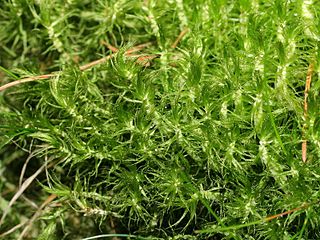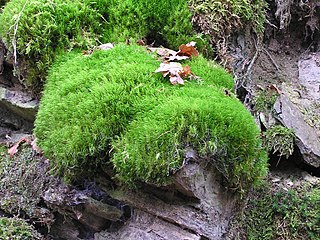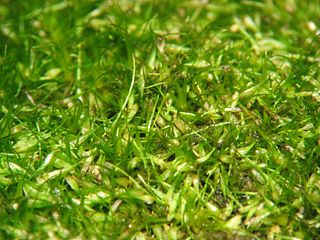NVC community H1 is one of the heath communities in the British National Vegetation Classification system. It is one of five communities categorised as lowland dry heaths.

Dicranum is a genus of mosses, also called wind-blown mosses or fork mosses. These mosses form in densely packed clumps. Stems may fork, but do not branch. In general, upright stems will be single but packed together. Dicranum is distributed globally. In North America these are commonly found in Jack pine or Red pine stands.

The wood lemming is a species of rodent in the family Cricetidae. It belongs to the rodent subfamily Arvicolinae, so is a relative of the voles, lemmings, and muskrats. It is found in the taiga biome of China, Estonia, Finland, Mongolia, Norway, Russia, and Sweden.

Blackheath is a 141.6-hectare (350-acre) biological Site of Special Scientific Interest south-east of Guildford in Surrey.

Dicranaceae is a family of haplolepideous mosses (Dicranidae) in class Bryopsida. Species within this family are dioicous. Genera in this family include Dicranum, Dicranoloma, and Mitrobryum.

Eudonia murana, the Scotch gray or wall grey, is a moth of the family Crambidae. It was described by John Curtis in 1827 and is found in most of Europe.

Dicranum scoparium, the broom forkmoss, is a species of dicranid moss, native to most of the northern hemisphere as well as Oceania. It usually forms tufts or mats on soil in dry to moist forested areas. As with many types of moss Broom moss grows in clumps with Broom mosses as well as other mosses. It can be distinguished by its leaves, which strongly curve to one side.

Olethreutes palustrana is a moth of the family Tortricidae. It is found in most of Europe, except the Iberian Peninsula and the Balkan Peninsula. It is also known from the eastern part of the Palearctic realm and North America. The habitat consists of heathland with scattered trees.
NVC community W17 is one of the woodland communities in the British National Vegetation Classification system. It is one of the six communities falling in the "mixed deciduous and oak/birch woodlands" group.

West's Meadow, Aldermaston is a 1.2-hectare (3.0-acre) biological Site of Special Scientific Interest south of Aldermaston in Berkshire.

Northpark Copse to Snapelands Copse is a 101.4-hectare (251-acre) biological Site of Special Scientific Interest north of Midhurst in West Sussex.

Dicranodontium denudatum is a species of moss belonging to the family Dicranaceae.
Dicranum drummondii is a species of moss belonging to the family Dicranaceae.
Dicranum spurium is a species of moss belonging to the family Dicranaceae.
Dicranum viride is a species of moss belonging to the family Dicranaceae.

Dicranum majus is a species of moss belonging to the family Dicranaceae.











